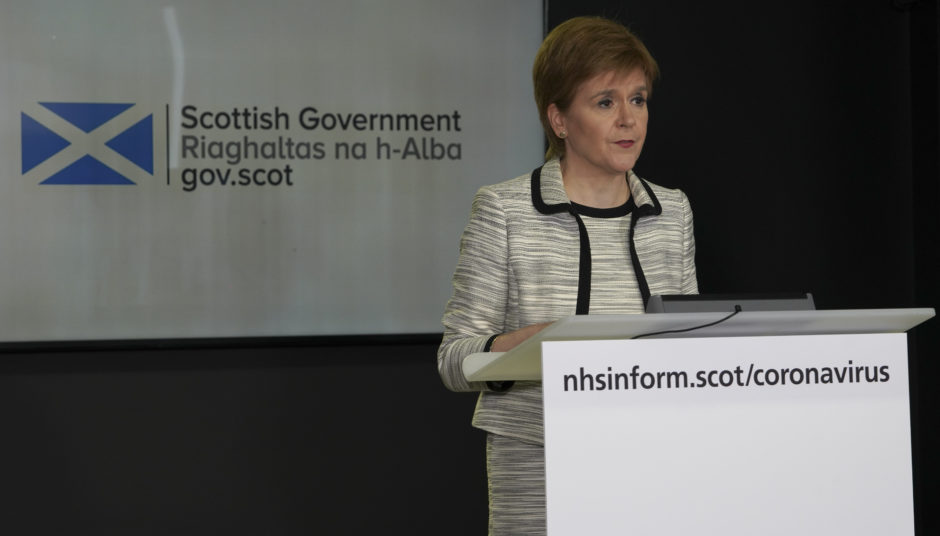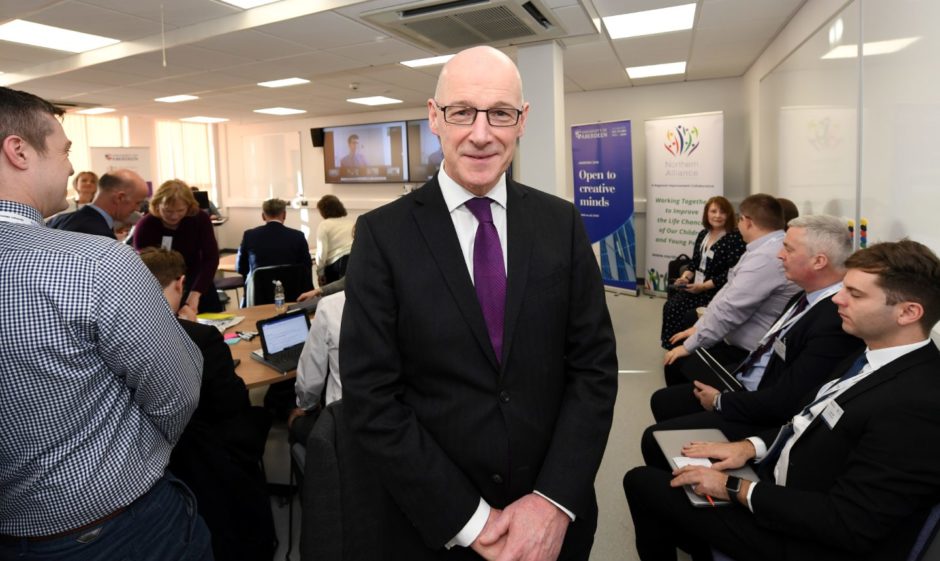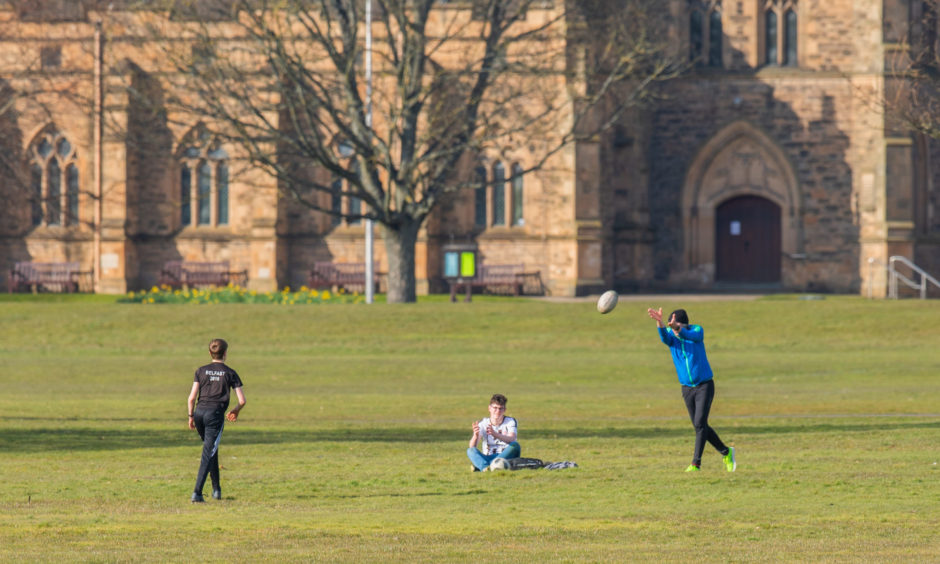From the reopening of schools and businesses to allowing more socialising, Nicola Sturgeon is exploring options for relaxing the coronavirus restrictions.
Her latest thinking on how the country can come out of the lockdown has been published in a Scottish Government document giving more detail on the “new normal” of living with Covid-19 that may emerge in the weeks ahead.
But, as ever, the potential courses of action come with a very loud note of caution.
The document reveals there are now around 26,000 infectious people in Scotland – a number that is “much too high” to consider the virus under control.
There is also a stark warning that fully reopening schools would overwhelm hospitals in just two months.
Therefore, the document talks of a phased approach to getting children back into the classroom. It also examines the prospects for businesses.
The chances of improving social lives by meeting in “bubbles” and getting outdoors more are also considered. As is the future of NHS operations and screening.
But it states that no dates can be put on any changes and warns that any steps must be taken with “extreme caution”. Indeed, they may be reversed if the spread of the virus accelerates.
The 26-page paper has been produced as a supplement to last month’s Covid-19 – A Framework for Decision Making, which gave the first glimpse into the future and the prospect of lifting the lockdown.
Here is a breakdown of the main points of Ms Sturgeon’s update.
The number of infectious people and the risk to the NHS
For the first time, the document puts an official number on the number of infectious cases. It estimated there are 26,000 people who can pass on the coronavirus – a figure with profound implications for the NHS.
“With the number of infectious people estimated at 26,000, this means that we are still at risk of a resurgence of the virus that would overwhelm NHS capacity,” the document states.
The R-number – or Reproductive Value that describes the rate the virus is transmitted – is estimated at between 0.7 and 1. The number tracks, on average, how many people will be infected for every person with the disease. There are suggestions the R number in Scotland is higher than elsewhere in the UK.

Should the R number go beyond 1, it risks exponential growth of hospitalisation and deaths. The document warns the figure at the moment is “too close to one”.
It adds: “The evidence is indicating that any change to the restrictions could easily lead to a resurgence of cases that would risk overwhelming NHS capacity in Scotland.”
Therefore, the document cannot conclude that the virus has been suppressed and so changes must be made with “extreme caution”.
“We consider that it would be unsafe to make anything other than marginal changes to restrictions until the estimated number of new cases is significantly lower,” it states.
The risks to the NHS of the premature reopening of schools
The bad news for children and parents is that the latest modelling suggests the “most likely” scenario is that full reopening of schools would “cause a resurgence in the virus such that hospital capacity in Scotland would be overwhelmed in less than two months”.
So what are the options for schools?
Schools will not reopen fully in the “foreseeable future”. There is also no certainty that they will reopen in any form in the “near future”. Nevertheless, a phased return of pupils is being considered by the government. Education Secretary John Swinney is chairing an Education Recovery Group (ERG) to look at such an approach.
That work will include coming up with a list of priority groups who would return to school in an agreed order. These would include vulnerable children, pupils in transition from primary to secondary school or those about to take key course in S3-6.
A new approach to learning is also being modelled. A blend of in-school and home-learning will be looked at to enable social distancing.
This would include attending school part-time in blocks of a few days or even a week at a time, to enable deep cleaning of schools between groups. Learning at home will be supported by consistent, high-quality online materials that will be developed to support the curriculum.
The future for business
The government will work with businesses and trade unions to support the reopening of certain businesses when safe to do so. Construction, manufacturing and retail businesses will be the focus of early talks.
Firms where workers struggle to work remotely will be considered. As will outdoor and rural businesses where transmission rates are likely to be lower.
The Construction Leadership Forum is developing a five-phase plan to support the restart of that sector, when it is safe to do so. Considerations will also cover related issues, such as managing the use of transport and the reopening of schools.
Restarting NHS services like screening and operations
To free-up NHS capacity for coronavirus patients some NHS services, such as cancer screening programmes and non-urgent operations, were suspended.
Ministers are examining how they can be restarted. In particular, elective procedures and screening services are being looked at. Also under consideration is the phased reintroduction of a wider range of social care support, such as therapeutic group activities.
The document says ministers are working to ensure changes are made in a fair and ethical manner that does not have a disproportionate impact on people like cancer patients, the elderly and the disabled who have “seen services diminish or stop completely”.
Getting outdoors and exercising more
Given that outdoor activity poses less transmission risk than indoor activity, ministers are considering letting people leave home more often or for longer than the current exercise limit of one hour.
This would still involve people staying in the local area and within their household group as well as maintaining social distancing and hygiene. Certain outdoor work activities may also be permitted in the future.
Improving social lives
Allowing people to meet small groups outside their households is also being considered. This would enable people to create a “bubble” of friends that acts as a single, self-contained unit without connections to other households.
This could be introduced for outdoor meetings at first before permitting such small gatherings inside. If anyone in the group developed symptoms of the disease, those people would need to self-isolate immediately for seven days, and the remainder of the bubble for 14 days.
Unfortunately, vulnerable people in the “shielded” category would not be allowed to be part of a bubble.



